Santiago Calatrava
| Santiago Calatrava Valls | |
|---|---|
|
Santiago Calatrava in 1999 | |
| Born |
28 July 1951 Benimàmet, Valencia, Spain |
| Nationality | Spanish |
| Education |
Polytechnic University of Valencia Swiss Federal Institute of Technology |
|
Engineering career | |
| Engineering discipline | Structural engineer, Architect, Sculptor |
| Institution memberships | Institution of Structural Engineers |
| Practice name | Santiago Calatrava |
| Significant projects |
Athens Olympic Sports Complex Auditorio de Tenerife Alamillo bridge Chords Bridge Ciutat de les Arts i les Ciències Liège-Guillemins railway station |
| Significant awards |
AIA Gold Medal IStructE Gold Medal Eugene McDermott Award Prince of Asturias Award Auguste Perret Prize |
Santiago Calatrava Valls (Valencian pronunciation: [santiˈaɣo kalaˈtɾava ˈvaʎs], born 28 July 1951) is a Spanish neofuturistic architect, structural engineer, sculptor and painter. He has offices in New York City, Doha, and Zürich, where he now resides.
Early life and education
Calatrava was born in Benimàmet, an old municipality now integrated as an urban part of Valencia, Spain, where he received a degree in architecture at the Polytechnic University of Valencia.[1] There he completed independent projects with fellow students, publishing two books on the vernacular architecture of Valencia and Ibiza. In 1975 he enrolled in the Swiss Federal Institute of Technology in Zürich, Switzerland, for a second degree in civil engineering. In 1981, after receiving his doctorate in civil engineering for his thesis, "On the Foldability of Space Frames", he started his architecture and engineering practice.
Career
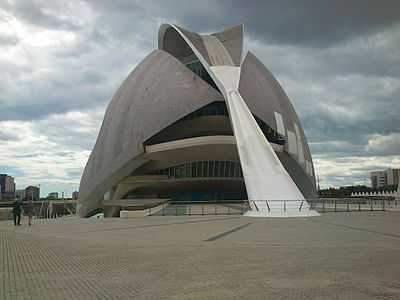
Calatrava's early career was largely dedicated to bridges and railway stations, with designs that elevated the status of civil engineering projects to new heights. His Montjuic Communications Tower in Barcelona, Spain (1991) in the heart of the 1992 Olympics site, as well as the Allen Lambert Galleria in Toronto, Canada (1992), were important works and turning points in his career, leading to a wide range of commissions. The Quadracci Pavilion (2001) of the Milwaukee Art Museum was his first building in the United States. Calatrava's entry into high-rise design began with an innovative 54-story-high twisting tower called Turning Torso (2005), located in Malmö, Sweden.
Calatrava has designed a neofuturistic railway station, the World Trade Center Transportation Hub, at the rebuilt World Trade Center in New York City. It is expected to open in 2015, six years behind schedule, at a cost of $4 billion, twice the original budget.[2]
In 2002 he was awarded the Sir Misha Black award and was added to the College of Medallists [3]
Calatrava has defined his style as bridging the division between structural engineering and architecture. In his projects, he claims to continue a tradition of Spanish modernist engineering that included Félix Candela, Antonio Gaudí, and Rafael Guastavino, with a very personal style that derives from numerous studies of the human body and the natural world. Architecture critics, however, see his work as a continuation of the neofuturistic expressionism of Eero Saarinen.[4][5]
On 10 December 2011, he was appointed a member of the Pontifical Council for Culture for a five-year renewable term by Pope Benedict XVI.[6]
In May 2012, Calatrava was accused of 'bleeding Valencia dry'.[2] Calatrava has charged some €100m (£81m) to the Valencia government, according to the website, established by the leftwing Esquerra Unida i Alternativa party. The party says it has managed to see copies of bills paid by the People's party regional government to the architect, who is now based in Zurich and thereore out of the immediate reach of Spanish courts.[7]
In March 2013, a supreme Italian court started a procedure for a hearing against Calatrava and three engineers for overpricing a bridge in Venice.[8]
Recent projects

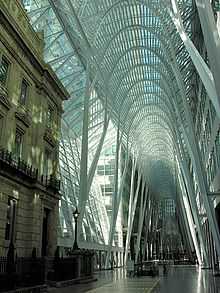
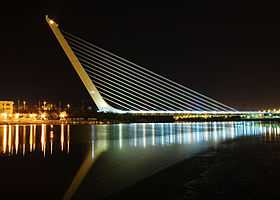


St. Nicholas Church
Calatrava's St. Nicholas Greek Orthodox Church, in Liberty Park, is a redesign for the church destroyed by the collapse of Two World Trade Center during the September 11 attacks.
Calatrava was awarded the contract to rebuild the St. Nicholas Church in downtown New York City, which had been destroyed on 9/11. Construction is expected to begin in 2014 and it is hoped that the St. Nicholas congregation will be able to celebrate Easter in the church in 2017.
The church will be created from steel and concrete but the exterior will be clad in stone. In designing the church, Calatrava was said to be inspired by Byzantine churches of the past, including the Haghia Sophia in Istanbul. The interior design of the church is still being determined.[9]
Sharq Crossing
In December 2013, the city of Doha awarded Calatrava the Sharq Crossing in Doha, Qatar - his biggest project to date. This project was put on hold in January 2015.[10] If pursued, the project will see three interconnecting bridges - spanning almost ten kilometers – connect the city’s cultural district in the north of the city to Hamad International Airport and the central business district in West Bay. The bridges will be able to carry 2,000 vehicles per lane per hour and are connected by a series of undersea tunnels to keep the traffic flow moving. The three bridges would be between 600 and 1,310m in length and the undersea tunnels would be between 8 and 9 km long.[11]
The crossing is partly designed to ease traffic in this fast-growing city, but the West Bay Bridge – a double-decked bridge – also incorporates a recreational part that can be accessed by an elevated walkway. This will offer views of the city and will offer hospitality facilities that connect to the central business district.
The project has been described by authorities in Qatar as being one of the most ambitious engineering projects undertaken in the Middle East, creating up to 15,000 jobs.[12] Work is scheduled to start in 2015 to open in time for the 2022 World Cup in Qatar.[13]
Trinity River Bridges
Calatrava's work includes three bridges that will eventually span the Trinity River in Dallas, Texas, United States. The first bridge, the Margaret Hunt Hill Bridge, named after donor Margaret Hunt Hill, was open for traffic in March 2012. The second, Margaret McDermott Bridge, named for the donor, started construction fall 2013 and is expected to open for traffic early 2017. If the remaining bridge is completed, Dallas will join the Dutch county of Haarlemmermeer in having three Calatrava bridges.
Work on the Margaret Hunt Hill Bridge was started in 2007 and completed in 2012. The bridge has a 40-story center arch, which is a feature of the Dallas skyline.[14]
Peace Bridge
Calatrava's design for the Peace Bridge, a 130 metres (430 ft) pedestrian bridge to span the Bow River in downtown Calgary, Alberta, Canada, was estimated to cost approximately $24.5 million. The project was approved by city council in early January 2009 and was scheduled for completion in fall 2010. Public disclosure of Peace Bridge plans was made on 28 July 2009, and it was described as a sleek, elegant contribution to downtown Calgary.
However, there was an uproar from Calgarians, since a bridge very similar to Calatrava's design was built in Toronto at a much lesser cost. The design model showed a sleek, tubular, single-span red-and-white trestle, offering separate pathways for cyclists and pedestrians. The bridge was expected to serve up to 5,000[15] pedestrians and cyclists daily. After considerable delays due to construction quality problems, the bridge opened in March 2012.[16]
Florida Polytechnic University
On 16 June 2009, it was announced that Calatrava would be designing the first building of the new University of South Florida Polytechnic campus in Lakeland, Florida. This will be his first work in the southeastern United States. The university is now Florida Polytechnic University scheduled to open in August 2014. As of 2013, construction of the campus is well under way on Interstate 4 between Tampa and Orlando. The Polytechnic will accept its first students in August 2014.[17]
Calatrava has been responsible for the masterplan of the campus as well as the main building. The campus sits on 170 acres (69 ha) of land which once contained phosphorus mines, many of which have been filled with water creating small lakes. Some of these are being enlarged to create a major lake at the center of the campus.
The main building – the Innovation, Science and Technology building – will be arranged over two floors of an area of 200,000 square feet. It will house classrooms, labs, faculty offices and meeting spaces and will be provide the Polytechnic’s primary needs until additional buildings are added.[18]
The project was completed for a fixed-price of $60m and is projected to come in under budget.[18] The backdrop of the polytechnic building was recently used in a commercial for Chrysler Ram trucks.[19]
Museum of Tomorrow, Rio de Janeiro
The Museum of Tomorrow is expected to open by June 2015. With Rio due to host a series of major events in the next few years, a number of high-profile construction projects were commissioned. Calatrava was responsible for the design of the Museum of Tomorrow, part of a major development on the waterfront. The museum – set on the Pier Maua, and over 130,000 square feet in size – will focus on the issues of science and sustainability, and look at possibilities for the future. The building will have a number of "green" features, including pools to capture rainwater for use in the plumbing system, and also pools that naturally filter water from the bay.[20]
Calatrava as sculptor
Calatrava is also a sculptor and painter, claiming that the practice of architecture combines all the arts into one. In 2003, the Metropolitan Museum of Art in New York City held an exhibition of his artistic and architectural work, entitled Santiago Calatrava: Sculpture Into Architecture. In 2012, the Hermitage Museum in St. Petersburg held an exhibition of his work[21] and this was followed up by an exhibition at the Vatican Museum in Rome.[22] The Marlborough Gallery in New York is set to exhibit Calatrava’s work in May 2014. Eight of his sculptures will also be displayed along Park Avenue in New York City in the spring of 2015, between 52nd and 55th Streets.[14] Exhibitions of his work have also taken place in Germany, England, Spain, Italy and elsewhere.
Notable works
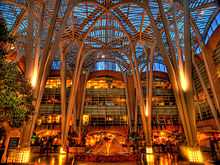

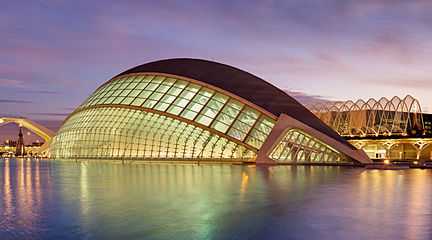
.jpg)


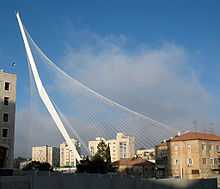

Completed
- 1983–84, Jakem Steel Warehouse, Munchwilen, Switzerland
- 1983–85, Ernsting Warehouse, Coesfeld, Germany
- 1983–88, Wohlen High School, Wohlen, Switzerland
- 1983–90, Stadelhofen Railway Station, Zürich, Switzerland
- 1983–89, Hall of Lucerne railway station, Lucerne, Switzerland
- 1984–87, Bac de Roda Bridge, Barcelona, Spain
- 1984–88, Barenmatte Community Center, Suhr, Switzerland,
- 1986–87, Tabourettli Theater, Basel, Switzerland,
- 1987–92, Allen Lambert Galleria (in Brookfield Place), Toronto, Canada,
- 1989–94, TGV Station, Lyon, France
- 1991–95, Alameda Bridge and Metro Station, Valencia, Spain
- 1992, Puente del Alamillo, Seville, Spain
- 1992, Puente de Lusitania, Mérida, Spain
- 1992, Montjuic Communications Tower at the Olympic Ring, Barcelona, Spain
- 1992, World's Fair, Kuwaiti Pavilion, Seville, Spain
- 1994, Mimico Creek Bridge, Humber Bay Parks, Toronto, Ontario
- 1994, Kronprinzenbrücke, Berlin, Germany
- 1994–1997, Campo Volantin Footbridge, Bilbao, Spain
- 1995, Trinity Bridge, footbridge over River Irwell in Manchester and Salford, Greater Manchester, England
- 1996–2009, Ciutat de les Arts i les Ciències, Valencia, Spain
- 1996, Centro Internacional de Ferias y Congresos de Tenerife, Santa Cruz de Tenerife, Tenerife, Canary island, Spain
- 1998, Gare do Oriente, Lisbon, Portugal
- 1999, Puente del Hospital, Murcia, Spain
- 2000, New terminal at Bilbao Airport, Bilbao, Spain
- 2001, Milwaukee Art Museum, Milwaukee, Wisconsin, US
- 2001, Puente de la Mujer, in the Puerto Madero barrio of Buenos Aires, Argentina
- 2001, Bodegas Ysios, Laguardia, Spain
- 2002, Wave, in Dallas, Texas at the Southern Methodist University Meadows Museum[23]
- 2003, James Joyce Bridge, bridge over River Liffey, Dublin, Ireland
- 2003, Auditorio de Tenerife, the architect's first performing arts facility, Santa Cruz de Tenerife, Spain
- 2004, redesign of Athens Olympic Sports Complex, Athens, Greece
- 2004, Sundial Bridge at Turtle Bay, Redding, California, US
- 2004, Three bridges (called Harp, Cittern and Lute) spanning the main canal of the Haarlemmermeer, Netherlands
- 2004, University of Zurich, "Bibliothekseinbau" library remodelling, Zürich, Switzerland
- 2005, The bridge connecting the Avnat shopping mall and the Rabin Medical Center (Beilinson) in Petah Tikva, Israel
- 2005, Turning Torso, Malmö, Sweden
- 2007, 3 Bridges on the A1 Motorway and Milan–Bologna high-speed railway, Reggio Emilia, Italy
- 2007–2012 Margaret Hunt Hill Bridge, Dallas, Texas, US
- 2008, Chords Bridge at the entrance to Jerusalem, Israel, a light rail bridge
- 2008, Ponte della Costituzione footbridge from Piazzale Roma over the Grand Canal, Venice, Italy
- 2008–2009, Technion Obelisk, monument on the Technion campus in Haifa, Israel
- 2009, Liège-Guillemins railway station in Liège, Belgium
- 2009, Samuel Beckett Bridge, bridge over River Liffey, Dublin, Ireland
- 2009, Caja Madrid Obelisk, Madrid, Spain
- 2011, Palacio de Congresos de Oviedo, Oviedo, Asturias, Spain, [Spanish wiki: es:Palacio de Congresos de Oviedo
- 2011, Palacio de Exposiciones y Congresos, Oviedo, Spain
- 2012, Peace Bridge, Calgary, Canada
- 2013, Medio Padana Station on the Milan–Bologna high-speed railway, Reggio Emilia, Italy
Under construction/proposed
- World Trade Center Transportation Hub, New York City, US
- St. Nicholas Greek Orthodox Church, New York City, US
- Florida Polytechnic University, Lakeland, Florida, US
- Atlanta Symphony Center, Atlanta, Georgia, US - Project canceled
- High-rise buildings on stilts on the River Liffey in Dublin[24]
- New railway station in Mons, Belgium
- Museu do Amanhã, Rio de Janeiro, Brazil
- Subway bridge over the Barra Channel, Rio de Janeiro, Brazil
- Yuan Ze University, Taipei, Taiwan
- City of Sport, University of Rome Tor Vergata, Italy
- The Marina Arechis Port Village, Salerno, Italy
- Station Emilia, Italy
- Margaret McDermott Bridge, Dallas, Texas, US
Calatrava has also submitted designs for a number of notable projects that were eventually awarded to other designers, including the Reichstag in Berlin and the East London River Crossing.
Unbuilt projects
- 80 South Street was a residential skyscraper, located at that address in New York City's financial district facing the East River. It was composed of ten townhouses in the shape of cubes stacked on top of one another. The townhouses move up a main beam and follow a staggered ladder-like pattern, providing each townhouse with its own roof. The "townhouse in the sky" design was supposed to attract a high-profile clientele willing to pay a hefty US$30 million for each cube. As of 2008, this project had been canceled; the Manhattan real estate market had gone soft, and none of the ten multimillion-dollar townhouses had been sold.[25]
- Chicago Spire was a now-canceled skyscraper in Chicago. Originally commissioned by Chicagoan Christopher Carley, the building site for the project was purchased by Irish developer Garrett Kelleher in July 2006 when Carley's financing plans fell through. Construction of the building was to begin in August 2007, for intended completion in 2011. The Chicago Spire would have been the tallest building in North America. The project was canceled in early 2010.[26]
- Collserola communications tower in Barcelona (1991). A tower shaped like a big white spaceship was proposed, but Norman Foster ultimately designed the tower.
- A bridge in Toronto to the Toronto Island Airport. Locals did not support the airport.
- A campus building for Ryerson University in Toronto, Canada. His design was dropped for a less expensive design.[27]
- New cathedral for the Diocese of Oakland, California, US. Preliminary design dropped in favor of that by local architect Craig Hartman (Skidmore, Owings & Merrill, San Francisco).
- New bridge across Cávado River, Barcelos, Portugal. It was dropped due to lack of funds.
- Substitute bridge (Wettstein Bridge) across Rhine River, Basel, Switzerland. It did not pass the cantonal referendum. A less expensive bridge was built instead.
- Maastricht University Campus, Maastricht, Netherlands
- Palma de Mallorca's Opera, Spain
Recognition
Calatrava has received numerous recognitions for his design and engineering work, for example for his use of steel and concrete.[28] In 1988, he was awarded with the Fazlur Khan International Fellowship by the SOM Foundation.[29] In 1990, he received the "Médaille d'Argent de la Recherche et de la Technique", in Paris. In 1992 he received the prestigious Gold Medal from the Institution of Structural Engineers. In 1993, the Museum of Modern Art in New York held a major exhibition of his work called "Structure and Expression". In 1998 he was elected to become a member of "Les Arts et Lettres", in Paris. In 2005 he received the Gold Medal from the American Institute of Architects (AIA).
In 2005, Calatrava was awarded the Eugene McDermott Award by the Council for the Arts of MIT. The award is among the most esteemed arts awards in the US.[30]
He is also a Senior Fellow of the Design Futures Council.[31]
Calatrava has received a total of twenty honorary degrees in recognition of his work. In 2013, Calatrava was awarded an honorary doctorate from Georgia Institute of Technology, an award that has only been given to a small number of people.[32][33]
The Nova Corps world Xandar in the science fiction film Guardians of the Galaxy is largely based on his designs.[34]
Awards
- 1979 Auguste Perret Award
- 1987 UIA Auguste Perret Prize
- 1988 City of Barcelona Art Prize
- 1991 Award for Good Building
- 1992 Brunel Award
- 1992 VI Dragados y Construcciones Prize
- 1992 London Institution of Structural Engineers Gold Medal
- 1993 Toronto Municipality Urban Design Award
- 1993 Urban Design Award
- 1995 Canton of Lucerne Award for Good Building
- 1996 Gold Medal for Excellence in the Fine Arts from the Granada Ministry of Culture
- 1997 ECCS European Steel Design Award
- 1998 Brunel Award
- 1999 Prince of Asturias Award in Arts
- 1999 Canadian Consulting Engineering Awards: Building and Structures
- 2000 Das Goldene Dach
- 2000 Algur H. Meadows Award for Excellence in the Arts from the Meadows School of the Arts, Southern Methodist University
- 2001 ECCS European Steel Design Award 2001
- 2002 Best Large Structure, Excellence in Structural Engineering Design Award
- 2002 Il Principe e l’Architetto
- 2003 The Silver Beam Award
- 2003 ECCS European Steel Design Award
- 2004 James Parks Morton Interfaith Award from the Interfaith Center of New York
- 2004 NCSEA Outstanding Project Award
- 2004 IABSE Outstanding Structure Award
- 2005 ECCS European Steel Design Award (for the Olympic Stadium, Athens)
- 2005 ECCS European Steel Design Award (for the Three Bridges over the Hoofdvart in the Netherlands)
- 2005 MIPIM Award
- 2005 American Institute of Architects Gold Medal
- 2006 Eugene McDermott Award in the Arts from the Council for the Arts at MIT (Massachusetts Institute of Technology)
- 2006 Honorary Engineering Degree from Rensselaer Polytechnic Institute
- Designation as a Global Leader for Tomorrow by the World Economic Forum in Davos
- 2006 ESCN European Award for Excellence in Concrete (for the Turning Torso in Malmo)
- 2006 ESCN European Award for Excellence in Concrete (for the Liege-Guillemins station in Belgium)
- 2006 Premio Nacional de Arcquitectura
- 2006 fib Award for Outstanding Concrete Structures
- 2006 Sidney L. Strauss Award
- 2006 Leadership Award, New York Building Congress
- 2006 Premio Nacional de Ingenieria Civil
- 2007 Awarded with the Spanish National Architecture Award
- Design Futures Council Senior Fellow
- 2007 “Hijo Predilecto”, Municipality of Valencia
- 2007 Urban Visionaries Award
- 2007 Premio Nacional de Arcquitectura
- 2008 Gran Cruz de la Orden de Jaume
- 2009 Gresol Foundation Award
- 2009 ECCS European Steel Design Award
- 2009 Golden Belgian Building Award
- 2010 Woodrow Wilson Award for Public Service
- 2010 Honorary Citizen of the City of Liege
- 2010 Project of the Decade Real Estate Award, The Business Journal
- 2011 Certificate of Brevet Wallonie
- 2012 AIA National Medal
- 2012 ECCS European Award for Steel Bridges
- 2013 CIS ICCA – Canadian Institute of Steel Construction, Steel Design Awards of Excellence
Honorary degrees
- 1993 Honorary Degree from Universidad Politecnica de Valencia
- 1994 Honorary Degree from Heriot-Watt University
- 1994 Honorary Degree from University of Seville
- 1995 Honorary Degree from University of Salford
- 1996 Honorary Degree from University of Strathclyde
- 1997 Honorary Degree from Milwaukee School of Engineering
- 1997 Honoris Causa degree awarded by Delft University of Technology
- 1999 Honorary Degree from Lund University
- 1999 Honorary Degree from Universita degli Studi di Ferrara
- 2004 Honorary Degree from Technion – Israel Institute of Technology
- 2005 Honorary Degree from Southern Methodist University
- 2005 Honorary Degree from Aristotle University of Thessaloniki
- 2007 Honorary Engineering Degree from Columbia University
- 2008 Honorary Degree from Tel Aviv University
- 2009 Honorary Degree from Oxford University
- 2009 Honorary Degree from University Camilo Jose Cela
- 2010 Honorary Degree from Universite de Liege
- 2012 Honorary Degree from Pratt Institute
- 2013 Honorary Doctoral degree from Georgia institute of technology[35]
Criticism
Calatrava's projects have often been completed late and well over budget,[36][37] resulting several times in real or threatened litigation against him. The World Trade Center Transportation Hub in New York is expected to be complete in 2015, six years behind schedule, for a cost of $4 billion, twice what was expected.
The City of Arts and Sciences complex in his native Valencia ultimately cost around €900 million, almost triple what was originally budgeted, over a 13-year period. Ignacio Blanco, an opposition member of the Valencian provincial parliament for United Left, estimates that the city, financially strapped as a result of country's ongoing economic crisis and unwise spending, still owes €700 million. Blanco started a website, calatravatelaclava.com[38] (a rhyme that means ¨Calatrava nails you (with it)", also very loosely translated from Spanish as "Calatrava bleeds you dry"), highlighting the architect's propensity for these cost and schedule overruns.[2][39] Calatrava has been accused of trying to silence his underfunded but vocal Valencian critics by suing them for large monetary damages.[40] Around May 2014, Calatrava won a court ruling requiring that the "insulting and degrading" website name be taken down, although the information on it was judged to be "within the limits of the criticism".[39] Esquerra Unida i Alternativa, the political party behind the website, launched another one called www.calatravanonoscalla.com, loosely translated as "Caltrava will not silence us".[39]
Some of Calatrava's work has additionally been criticized for impracticality. The metal arches he puts over landscaped gardens, critics say, are beautiful but became too hot in the sunlight for vines to grow around them.[2] In Bilbao, the bridge's glass tiles are prone to break and to become slippery in the local weather,[41] leading The New York Times to dub it "The Bridge of Broken Legs", due to the many accidents that occurred. The compensation payments which followed finally compelled the local administration to add anti-slip treads to its decking, covering the lighting from underneath that was the bridge's selling point. In the City of Arts and Sciences' opera house, 150 seats have partially obstructed views. "[R]ather than searching for functionality or customer satisfaction, he aims for singularity," complains the head of Bilbao's architectural association. "[He] is above and beyond the client." Blanco points to the minimal design notes the architect provides in comparison to his peers.[2]
Other buildings have been built without essential features. Bilbao Airport lacks an arrivals hall, so a glass wall had to be built to shelter passengers waiting on the street after clearing customs and picking up their bags. Valencia's science museum was originally missing fire escapes or elevators to provide accessibility; they were later added by Calatrava at further public expense. "He was paid even when repairing his own mistakes," Blanco complains.[2]
Some Calatrava projects have shown visible problems within a few years of completion. It was inevitable, another Valencia architect wrote, that the mosaic Calatrava put on the wall of the City of Arts and Sciences' opera house as a tribute to Antonio Gaudi would buckle as the steel it was affixed to heated up. The city was contemplating a lawsuit against Calatrava and the builders over the wrinkles that have appeared. Tiles on the facade were ripped away by high winds in the winter of 2013-2014. Eventually, the blame was assigned to the contractor responsible for attaching the tiles with adhesive, and repairs are planned.[39]
A councilor in the Dutch municipality Haarlemmermeer called for the city to sue Calatrava over the three bridges he designed over its main canal, which not only cost double their budget but have required far more maintenance than originally anticipated.[2]
_-_Foto_di_Paolo_Steffan.jpg)
The Constitution Bridge over the Grand Canal in Venice has many problems highlighted by his critics. Begun in 1996, it took 12 years to build and went through numerous structural changes because of the mechanical instability of the structure and the excessive weight of the bridge,[42] which would cause the banks of the canal to fail. In 10 years the project was inspected by more than eight consultants and the cost had risen to three times the original expectations.[43] The finished bridge has been criticized for its impractical design; it has many steps embedded in its relatively steep pavement, which makes it uncomfortable to walk on, especially for the elderly. Moreover, it does not have a ramp, so that it cannot be used by wheelchair users. The city has sued Calatrava over both the cost overruns on the original construction and the excessive maintenance costs since then.[2]
The Domecq Group has sued Calatrava and the building company Ferrovial to pay for the repairs in the cover of the 2001 Ysios winery in Alavan Rioja, Spain.[44] The aluminium and cedar cover leaks water, causing humidity inside that is detrimental to wine production.
Elsewhere in Spain, in 2013 Calatrava and his associates were ordered to pay the city of Oviedo €3.3 million for damages incurred when a convention center collapsed while under construction.[2] The judgment has since been confirmed on appeal, though slightly reduced to just under €3 million.[45]
"My goal is always to create something exceptional that enhances cities and enriches the lives of the people who live and work in them," Calatrava told the New York Times in response to its article about his projects' many difficulties. He has claimed that his fees for his Valencia work were justified since they included his work as a project manager over 20 years' time, but did not address specific criticisms of its many defects. In an interview with Architectural Record he dismissed criticism there by Blanco and others as politically motivated. He noted that other cities, like Dublin and Dallas, had been satisfied with his work and commissioned projects from him repeatedly. His supporters pointed out that Valencia's government has spent foolishly and extravagantly on other architects' work as well, such as its new airport which remains underused.[2]
Exhibits
A special one-man exhibition of Calatrava's drawings, sculpture, and architectural models was presented at the Metropolitan Museum of Art in March 2006.[46][47]
Personal life
Calatrava's nephew Álex Calatrava is a professional tennis player. Two of Calatrava's sons have completed or are in the process of completing advanced degrees in Engineering from the Fu Foundation School of Engineering and Applied Science at Columbia University in New York City. His other son has just finished law school at Columbia University.
References
- ↑ "Biography: Santiago Calatrava". Southern Methodist University News. 7 October 2002. Retrieved 12 November 2013.
- ↑ 2.0 2.1 2.2 2.3 2.4 2.5 2.6 2.7 2.8 2.9 Daley, Suzanne (13 September 2013). "A Star Architect Leaves Some Clients Fuming". The New York Times. Retrieved 13 September 2013.
- ↑ "The Sir Misha Black Medal | Misha Black Awards". mishablackawards.org.uk. Retrieved 29 April 2014.
- ↑ http://www.infoplease.com/encyclopedia/people/calatrava-santiago.html
- ↑ Architectural Record | Interviews | Santiago Calatrava
- ↑ NOMINA DI MEMBRI DEL PONTIFICIO CONSIGLIO DELLA CULTURA
- ↑ Giles Tremlett (8 May 2012). "Architect Santiago Calatrava accused of 'bleeding Valencia dry'". The Guardian. Retrieved 13 November 2013.
- ↑ Ferran Bono (12 March 2013). "No pagaremos por los desperfectos de Calatrava en el Palau de les Arts" (in Spanish). El País. Retrieved 13 November 2013.
- ↑ Sirigos, Dean (March 8, 2014). "Hagia Sophia Spirit Abound in Calatrava’s St. Nicholas Ground Zero Church Design". The National Herald. Retrieved May 29, 2014.
- ↑ Report: Qatar places Sharq Crossing project on hold - Doha News
- ↑ Mathew, Ramesh (December 17, 2013). "Doha’s iconic Sharq Crossing project unveiled". Gulf Times. Retrieved May 29, 2014.
- ↑ Kovessy, Peter (December 16, 2013). "Sharq Crossing construction to commence in 2015". Doha News. Retrieved May 29, 2014.
- ↑ Allen, Katherine (May 29, 2014). "Calatrava’s "Sharq Crossing" Planned for Doha Skyline". Arcj Daily. Retrieved May 29, 2014.
- ↑ 14.0 14.1 Chaban, Matt (March 21, 2014). "The canvas and creativity drive renowned architect Santiago Calatrava's structures". New York Daily News. Retrieved May 29, 2014.
- ↑ "The Peace Bridge hits the mark". City of Calgary. Retrieved 2013-05-29.
- ↑ "2012 in Review: Top 10 Projects – Azure Magazine". azuremagazine.com. Retrieved 29 April 2014.
- ↑ Bennett, Lennie (March 17, 2014). "Soaring Calatrava design will be centerpiece of Florida Poly". Tampa Bay Times. Retrieved May 29, 2014.
- ↑ 18.0 18.1 Jones, Jenny (February 24, 2014). "Calatrava Designs Campus, First Academic Building". Civil Engineering. Retrieved May 29, 2014.
- ↑ Mitchell, Tia (February 10, 2014). "Florida Poly campus featured in Dodge Ram commercial". Tampa Bay Times. Retrieved May 29, 2014.
- ↑ Murdock, James (October 10, 2010). "Calatrava’s "Museum of Tomorrow" to Showcase a Greener Future for Rio". Architectural Record. Retrieved May 29, 2014.
- ↑ "‘Santiago Calatrava: The Quest for Movement’ Exhibition". Arch Daily. 2 July 2012. Retrieved May 29, 2014.
- ↑ "Santiago Calatrava: The Metamorphosis of Space". Arch Daily. 5 December 2013. Retrieved May 29, 2014.
- ↑ "Sculpture by Santiago Calatrava to be unveiled at SMU's Meadows Museum". Southern Methodist University News. 7 October 2002. Retrieved 13 November 2013.
- ↑ High-rise towers on stilts plan for Liffey – Irish Architectural News
- ↑ Proposed: 80 South Street - Lower Manhattan
- ↑ Calatrava Dances onto a New Stage - Business Week
- ↑ Graphic of the Ryerson Centre for Computing and Engineering, Ryerson Centre for Computing and Engineering, Toronto, Canada, Photo, Stock Image, Photograph | Emporis.com
- ↑ "Santiago Calatrava Awards". Retrieved May 29, 2014.
- ↑ "SOM Foundation Fellows Archive".
- ↑ Established to honor Eugene McDermott, founder of Texas Instruments and long-time friend and benefactor to MIT, the award was created by the Council for the Arts at MIT in 1974, and further endowed by Eugene's wife, Margaret. Since its inception, the Council has bestowed the award upon 31 individuals producing creative work in the performing, visual and media arts, as well as authors, art historians and patrons of the arts.
- ↑ "Senior Fellows - Design Futures Council". Design Intelligence. Retrieved 13 November 2013.
- ↑ Treadaway, Dan (Fall 2013). "Santiago Calatrava: Blurring Boundaries". Georgia Tech. Retrieved May 29, 2014.
- ↑ Herman, Lisa. "Architect John Portman honored with Council for Quality Growth's Four Pillars Award", Georgia Tech, November 10, 2013. Accessed May 29, 2014. "...Doctorate of Philosophy by Georgia Tech, an accolade only a handful of individuals have achieved..."
- ↑ Guardians of the Galaxy (2014) - Trivia - IMDb
- ↑ "YouTube - Dr. Santiago Calatrava Receives Honorary Degree and Remarks". youtube.com. Retrieved 29 April 2014.
- ↑ Smith, Stephen Jacob (April 8, 2013). "Municipal Art Society Thinks Calatrava Deserves a Second Chance". New York Observer. New York Observer. Retrieved 2014-05-30.
- ↑ ELPAIS.com – Sólo texto – Calatrava y sus desmanes
- ↑ calatravatelaclava.com
- ↑ 39.0 39.1 39.2 39.3 "Santiago Calatrava wins legal battle against 'insulting and degrading' website". De Zeen Magazine. De Zeen Magazine. Retrieved 2014-05-30.
- ↑ "Calatrava demanda a EUPV por denigrarle en la web ‘calatravatelaclava’" (in Spanish). El Pais. 30 Janunary 2014. Retrieved 30 January 2014. Check date values in:
|date=(help) - ↑ Entre losetas y y arquitectos 'estrellas', El Correo, 24 February 2007.
- ↑ Roberto Bianchini (7 May 2007). "Troppo pesante quel ponte per Venezia" (in Italian). La Repubblica. Retrieved 13 November 2013.
- ↑ , L'Espresso, 8 May 2007.
- ↑ Los "patinazos" de Calatrava, Descubrir el arte, 17 April 2013.
- ↑ "La Audiencia Provincial de Oviedo condena a Santiago Calatrava" (in Spanish). El Pais. 7 February 2014. Retrieved 7 February 2014.
- ↑ The Metropolitan Museum of Art – Special Exhibitions: Santiago Calatrava: Sculpture Into Architecture
- ↑ Images from the March 2006 Metropolitan Museum of Art exhibition.
Further reading
- Tzonis, Alexander (1999). Santiago Calatrava: The Poetics Of Movement. Universe. ISBN 0-7893-0360-4.
- Tzonis, Alexander (2004). Santiago Calatrava: The Complete Works. Rizzoli. ISBN 0-8478-2641-4.
External links
| Wikimedia Commons has media related to Santiago Calatrava. |
- Official Website
- Santiago Calatrava News Aggregator
- Great Buildings On-Line: Santiago Calatrava
- Unofficial website
- Calatrava's projects on the map
- Extended profile of the architect in the NYRB, December 2006
- The New Yorker, 31 October 2005, "The Sculptor"
- The Guardian, 17 January 2006, "The Gaudí Effect"
- Pictures and profile at Specifier
- Many pictures of Calatrava's Art on Trekearth
- Calatrava's 80 South Street condo design for New York
- CNN interview with Santiago Calatrava
- Proposed design for south terminal expansion at Denver International Airport
- Corruption in Calatrava's projects exposed by spanish left-wing party United Left (IU)
- Santiago Calatrava Architecture on Google Maps
| ||||||
|
